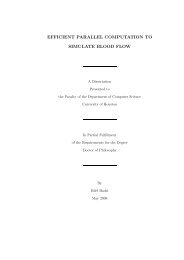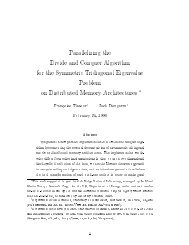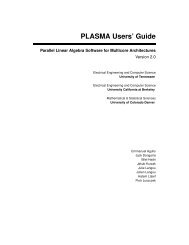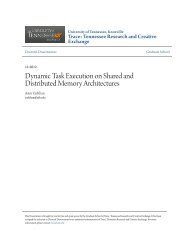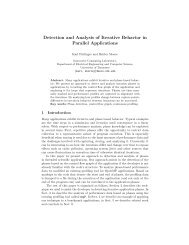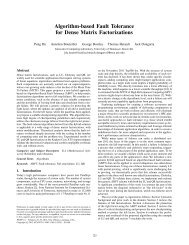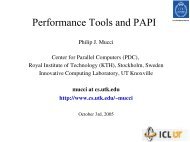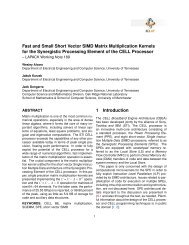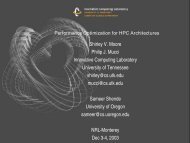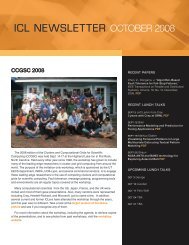Scheduling Linear Algebra Operations on Multicore ... - Netlib
Scheduling Linear Algebra Operations on Multicore ... - Netlib
Scheduling Linear Algebra Operations on Multicore ... - Netlib
You also want an ePaper? Increase the reach of your titles
YUMPU automatically turns print PDFs into web optimized ePapers that Google loves.
cilk void dsyrk(double *A, double *T);<br />
cilk void dpotrf(double *T);<br />
cilk void dgemm(double *A, double *B, double *C);<br />
cilk void dtrsm(double *T, double *C);<br />
for (k = 0; k < TILES; k++) {<br />
spawn dpotrf(A[k][k]);<br />
sync;<br />
for (m = k+1; m < TILES; m++)<br />
spawn dtrsm(A[k][k], A[m][k]);<br />
sync;<br />
for (m = k+1; m < TILES; m++) {<br />
for (n = k+1; n < m; n++)<br />
spawn dgemm(A[k][n], A[m][n], A[m][k]);<br />
spawn dsyrk(A[k][n], A[k][k]);<br />
}<br />
sync;<br />
}<br />
code synchr<strong>on</strong>izes at each step, but panels are always<br />
overlapped with updates. This approach implements<br />
<strong>on</strong>e-level lookahead (lookahead of depth <strong>on</strong>e). Imvoid<br />
dsyrk(double *A, double *T);<br />
void dpotrf(double *T);<br />
void dgemm(double *A, double *B, double *C);<br />
void dtrsm(double *T, double *C);<br />
cilk void cholesky_panel(int k)<br />
{<br />
int m;<br />
}<br />
dpotrf(A[k][k]);<br />
for (m = k+1; m < TILES; m++)<br />
dtrsm(A[k][k], A[m][k]);<br />
cilk void cholesky_update(int n, int k)<br />
{<br />
int m;<br />
dsyrk(A[k][n], A[k][k]);<br />
for (m = n+1; m < TILES; m++)<br />
spawn dgemm(A[k][n], A[m][n], A[m][k]);<br />
if (n == k+1)<br />
spawn cholesky_panel(k+1);<br />
Figure 4: Cilk implementati<strong>on</strong> of the tile Cholesky<br />
factorizati<strong>on</strong> with 2D work assignment (right-looking<br />
versi<strong>on</strong>).<br />
It is not possible to further improve parallelism by<br />
pipelining the steps of the factorizati<strong>on</strong>. Nevertheless,<br />
most of the work can proceed in parallel and<br />
<strong>on</strong>ly the dpotrf() task has to be executed sequentially.<br />
Since the disregard for data reuse between tasks<br />
may adversely affect the algorithm’s performance, it<br />
is necessary to c<strong>on</strong>sider an implementati<strong>on</strong> facilitating<br />
data reuse. One possible approach is processing<br />
of the tiles of the input matrix by columns. In this<br />
case, however, work is being dispatched in relatively<br />
big batches and load imbalance in each step of the<br />
factorizati<strong>on</strong> will affect performance. A traditi<strong>on</strong>al<br />
remedy to this problem is the technique of lookahead,<br />
where update of step N is applied in parallel with<br />
panel factorizati<strong>on</strong> of step N + 1. Figure 5 shows<br />
such implementati<strong>on</strong>, referred here as Cilk 1D.<br />
First, panel 0 is factorized, followed by a sync.<br />
Then updates to all the remaining columns are issued<br />
in parallel. Immediately after updating the first<br />
column, next panel factorizati<strong>on</strong> is spawned. The<br />
}<br />
spawn cholesky_panel(0);<br />
sync;<br />
for (k = 0; k < TILES; k++) {<br />
for (n = k+1; n < TILES; n++)<br />
spawn cholesky_update(n, k);<br />
sync;<br />
}<br />
Figure 5: Cilk implementati<strong>on</strong> of the tile Cholesky<br />
factorizati<strong>on</strong> with 1D work assignment (right-looking<br />
versi<strong>on</strong>).<br />
plementing more levels of lookahead would further<br />
complicate the code.<br />
4.2 SMPSs Implementati<strong>on</strong><br />
Figure 6 shows implementati<strong>on</strong> using SMPSs. The<br />
functi<strong>on</strong>s implementing parallel tasks are designated<br />
with #pragma ccs task annotati<strong>on</strong>s defining directi<strong>on</strong>ality<br />
of the parameters (input, output, inout).<br />
The parallel secti<strong>on</strong> of the code is designated with<br />
#pragma ccs start and #pragma ccs finish annotati<strong>on</strong>s.<br />
Inside the parallel secti<strong>on</strong> the algorithm is<br />
implemented using the can<strong>on</strong>ical representati<strong>on</strong> of<br />
four loops with three levels of nesting, which closely<br />
7



